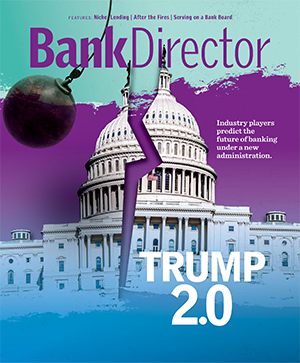
Do Strategic Plans Still Make Sense?

It was relatively easy for community bank CEOs and their boards to make a strategic plan five years ago when the economy was booming and it wasn’t hard for lenders to put their institution’s money to work. Then “life happened” in 2008 when the U.S. economy tanked and the fuel that drove bank earnings through the middle part of the previous decade – commercial real estate – became too dangerous and unstable for banks to use.
While the U.S. economy has posted five consecutive quarters of GDP growth through the third quarter of 2010, it seems that many business borrowers lack faith in the recovery because loan demand remains slack. The commercial real estate market is still pretty toxic, and bank regulators have been putting pressure on a lot of banks to downsize their CRE portfolios anyway.
So what’s the plan when no one wants your biggest product?
One could argue that the regulators have been driving the planning process at many banks. “They have told banks to reduce [their] CRE [exposure] by ‘X’ percent,” says Michelle Gula, president and CEO at mrae associates inc., a consulting firm that works exclusively with community banks. “They’ll come down on you if you’re not in the zone where they want you to be.”
Gula makes the fair point that for many troubled institutions today, the “strategic plan” ends up focusing on an immediate problem that has come under regulatory scrutiny and must be fixed. “Now the strategic plan needs to be very targeted,” says Gula. “You have to identify exactly how you’re going to get it done.”
And yet banks still must find a way to grow, and if they have been too reliant on CRE lending, that could require a change in their business model. How should they do that?
Back in the late 1980s I left magazine journalism to work as a speech writer at insurance broker Marsh & McLennan Inc. One of my duties was to write the annual business plan. (It sounds more impressive than it actually was. I was just the writer. Others were the thinkers.) Marsh’s strategic plan came together in what I would describe as a bottom-up process. Every significant Marsh business unit throughout the country had to submit its own plan for the coming year and present it to senior management. Eventually this deliberate process yielded a company-wide plan that was a distillation of the best opportunities – and best ideas – from throughout the firm. In other words, Marsh’s local markets and individual business units drove its strategy. There were top-down initiatives as well. But Marsh never strayed too far away from its markets and the people who knew them best.
In this context, the only difference between Marsh and a community bank is that Marsh had many markets and a local bank just one. But this is exactly where Geri Forehand, the national director of strategic services at Sheshunoff Consulting + Solutions, says banks should be looking for new growth ideas.
As they moved away from CRE, several of Forehand’s bank clients have developed new industry or business niches based on opportunities in their markets. One bank has concentrated on property management companies, another has zeroed in on local governments and non-profit organizations, while others have placed more emphasis on trust and investment management as their customers shift from spending to saving. Often, it’s necessary for the bank to hire experienced lenders and relationship managers who understand the new business sector, although Forehand says this is a good time to hire talented people from other banks.
“You have to evaluate the market and what it’s going to give you,” says Forehand. “And you have to evaluate people and determine whether you have the right ones. Managing the human capital side is as important as anything right now.”
I would argue that given the many challenges banks face today, including the decline of the CRE market, strategic planning is more important than ever. Find a niche or specialty in your market that is underserved, develop a strategy for attacking that market, hire the necessary talent and go for it.
Life happens, but that’s no reason to stop making plans.



